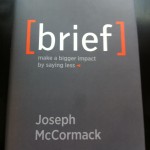 There is an irony to this book. Joseph McCormack, the founder and CEO of Sheffield Marketing Partners, knows that. Lest you think you are the first person to ask why someone would write a book on being brief (and not just a paragraph!) McCormack wants you to know that he’s thought of this. “When I first told my wife, Montse, and kids that I was writing a book called Brief, the jokes started flying,” he writes in the acknowledgements. “You could only imagine their comments. My friends and extended family followed suit saying the book should be only 10 pages long.”
There is an irony to this book. Joseph McCormack, the founder and CEO of Sheffield Marketing Partners, knows that. Lest you think you are the first person to ask why someone would write a book on being brief (and not just a paragraph!) McCormack wants you to know that he’s thought of this. “When I first told my wife, Montse, and kids that I was writing a book called Brief, the jokes started flying,” he writes in the acknowledgements. “You could only imagine their comments. My friends and extended family followed suit saying the book should be only 10 pages long.”
He thanks them for their love and support anyway, but in the 200 pages of Brief: Make a Bigger Impact by Saying Less, he never gives a solid answer to this critique. To be sure, the thesis of this book is strong: In communication, brevity is your friend. Clear language and compelling stories cut through the clutter of modern life. And modern life is cluttered. We spend our days getting hundreds of emails and being interrupted every 8 minutes. Busy people need straight talk, not 98-slide PowerPoint decks. “If you are used to preparing a seven-course meal, get ready to serve tapas,” McCormack writes. “You and your company are going to stand out and get people’s attention. You are going to be remembered and your ideas are going to be sticky.”
To which I say — yes! McCormack follows his own advice, and creates a tapas style book that allows for visual grazing. There are comics. He gives you the highlight of each (extremely brief) chapter in a “Long story, short” summary. He employs ample anecdotes of people who’ve failed to be brief and lost their audience, or people who used clear, concise language and won business as a result. It is a breezy book, a fast read.
And yet the question is why read it. I’ve given you the summary already. Whatever you’ve got to say, see if you can say it in fewer words. See if you can take less time. People are busy. He offers tips on how to do this — create outlines, and watch TED talks for inspiration — but not hundreds of tips on how to write tight, or even as many as Strunk & White do (in half as many pages). Why turn this message into a 200-page book when a 2000-word how-to article would suffice?
The answer is that while brevity is great, it is not the only thing that matters. McCormack has a Big Idea, and in the world of business publishing, we like our Big Ideas in book form. Books need to have about 200 pages to justify printing, and to be handed out as something that seems valuable at speeches and conferences. McCormack and Wiley (his publisher) assume his idea will be treated more seriously as a 200-page book full of illustrations and examples than it would be as a 2000-word idea printed as a 5-page PDF. And so they chose not to be as brief as possible.
Which is great. But it also suggests that perhaps there are reasons other people might not be as brief as possible, too. He praises USA Today’s graphics, and I love USA Today as well (I’ve written for them for almost 13 years now!) But that is not the only way to convey news, and sometimes there is a place for building a narrative that is an experience to consume. That’s not an ode to wordiness. It’s about using the right medium for the message.
Laura, I’m enjoying your book reviews. The last phrase caught my attention–“It’s about using the right medium for the message.” Your dad has spoken to a variety of audiences recently–from academics not in his field to retirees in Florida to a men’s prayer breakfast. I think he was given great compliments when he was told that “he had pitched it just right.”
@Mary – it is a skill! Glad to know dad has it 🙂
@Mom- and I meant @mom — I just normally respond with first names to comments without thinking. Whoops!
giggle 😉
Reminds me of a book I read recently called How To Write Short. I need to work on this.